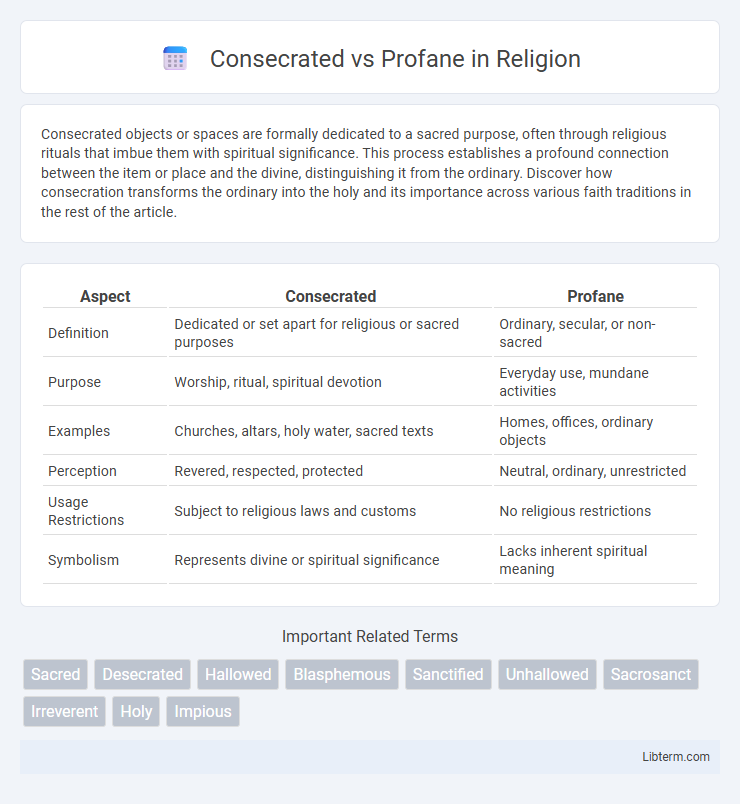Consecrated objects or spaces are formally dedicated to a sacred purpose, often through religious rituals that imbue them with spiritual significance. This process establishes a profound connection between the item or place and the divine, distinguishing it from the ordinary. Discover how consecration transforms the ordinary into the holy and its importance across various faith traditions in the rest of the article.
Table of Comparison
| Aspect | Consecrated | Profane |
|---|---|---|
| Definition | Dedicated or set apart for religious or sacred purposes | Ordinary, secular, or non-sacred |
| Purpose | Worship, ritual, spiritual devotion | Everyday use, mundane activities |
| Examples | Churches, altars, holy water, sacred texts | Homes, offices, ordinary objects |
| Perception | Revered, respected, protected | Neutral, ordinary, unrestricted |
| Usage Restrictions | Subject to religious laws and customs | No religious restrictions |
| Symbolism | Represents divine or spiritual significance | Lacks inherent spiritual meaning |
Introduction to Consecrated and Profane
Consecrated refers to something sacred, dedicated, or set apart for religious or spiritual purposes, often marked by rituals and ceremonies that imbue it with sanctity. Profane denotes things that are ordinary, secular, or lacking any sacred significance, commonly associated with everyday life and non-religious contexts. Understanding the contrast between consecrated and profane highlights the human tendency to distinguish between the sacred realm and the mundane world in cultural and religious practices.
Defining Consecrated: Meaning and Significance
Consecrated refers to something formally dedicated or set apart for a sacred purpose, often within religious contexts such as consecrated ground, objects, or persons. Its significance lies in symbolizing purity, devotion, and divine authority, distinguishing the consecrated from the ordinary or profane. This distinction establishes moral and spiritual boundaries that guide worship, ritual practices, and ethical behavior.
Understanding Profane: Origins and Context
Profane refers to things that are ordinary, secular, or outside the sacred realm, often associated with everyday life and common experiences. Its origins trace back to Latin "profanus," meaning "before the temple," signifying what lies outside sacred spaces and rituals. Understanding profane involves recognizing its role as the counterpart to consecrated elements, emphasizing the distinction between the sacred and the ordinary in religious and cultural contexts.
Historical Perspectives on Sacred and Profane
Historical perspectives on sacred and profane concepts reveal how ancient civilizations distinguished between divine and ordinary realms, shaping rituals and social structures. Emile Durkheim's seminal work emphasized that societies organize experiences into sacred (worthy of reverence) and profane (commonplace) categories, reflecting collective beliefs and moral systems. Archaeological findings and religious texts across cultures consistently demonstrate the enduring human effort to demarcate sacred spaces, objects, and times from profane daily life.
Religious Interpretations and Doctrines
Consecrated spaces and objects are set apart through religious rituals to embody sacredness and divine presence, reflecting doctrines that emphasize purity, sanctity, and spiritual authority. Profane elements, by contrast, represent the ordinary and secular realm, often regarded in religious teachings as lacking an inherent spiritual dimension or requiring transformation to attain holiness. Various faith traditions delineate strict boundaries between consecrated and profane, reinforcing moral codes and guiding worship practices based on these theological distinctions.
Cultural Manifestations of Consecration and Profanity
Cultural manifestations of consecration often involve rituals, symbols, and sacred spaces that denote holiness, such as temples, religious ceremonies, and relics revered in various faiths. In contrast, manifestations of profanity typically include everyday secular objects or acts considered taboo or offensive within certain cultural or religious contexts, reflecting societal boundaries between the sacred and the mundane. The dichotomy between consecrated and profane elements shapes social values, behavior norms, and identity through continuous cultural reinforcement and communal participation.
Rituals and Practices: Separating Sacred from Secular
Consecrated rituals emphasize sacred objects, spaces, and actions dedicated to divine purpose, often involving elaborate ceremonies, prayers, and invocations that set them apart from everyday life. Profane practices pertain to secular or mundane activities with functional or social intent, lacking sacred symbolism and formal sanctification. The distinction between consecrated and profane is maintained through ritualistic boundaries, marking the transition from ordinary contexts to spiritual significance.
Consecrated Spaces vs. Profane Places
Consecrated spaces are areas dedicated to sacred purposes, often marked by rituals, religious symbols, and a heightened sense of spiritual significance. These spaces are designed to evoke reverence and facilitate worship, contrasting sharply with profane places, which serve secular, everyday functions without intrinsic spiritual meaning. The distinction underscores how consecrated spaces shape cultural and religious identity, while profane places support routine, non-sacred activities.
Implications for Modern Society and Ethics
Consecrated spaces and objects carry symbolic significance that fosters community identity and moral order, influencing modern society by promoting respect for heritage and collective values. The distinction between consecrated and profane elements shapes ethical considerations by encouraging reverence, responsibility, and mindfulness in both religious and secular contexts. These implications drive contemporary debates on cultural preservation, public space usage, and the ethical treatment of sacred symbols.
Conclusion: Navigating the Sacred-Profane Divide
Navigating the sacred-profane divide requires understanding that consecrated spaces, objects, and rituals hold symbolic meaning that elevates them above ordinary experiences, while profane elements belong to everyday reality without inherent spiritual significance. Recognizing this distinction helps individuals respect religious practices and cultural values, fostering social cohesion and personal meaning. Balancing reverence for the sacred with functional use of the profane enables a harmonious coexistence in both communal and individual contexts.
Consecrated Infographic

 libterm.com
libterm.com